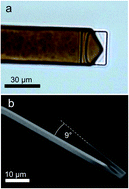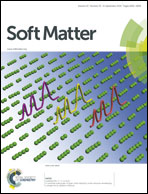A novel contact model for AFM indentation experiments on soft spherical cell-like particles
Abstract
The use of the simple Hertz model for the analysis of Atomic Force Microscopy (AFM) force–distance curves measured on soft spherical cell-like particles leads to significant underestimations of the objects Young's modulus E. To correct this error, a mixed double contact model (based on the simple Hertz model and the Johnson–Kendall–Roberts (JKR) model) was derived. The model considers two independent particle deformation sites: (i) the upper part of the particle is deformed by the AFM indenter, (ii) the bottom part is deformed by the substrate, which is usually unnoticed. It becomes apparent that for soft particles even small forces between substrate and particle can influence the resulting force–distance curves. For instance we show, that a gravity-induced compression on the particle bottom side can have significant influence on the measurements. To highlight these observations, the deviation of the particle Young's modulus E between the simple Hertz model and our model is calculated. This error strongly depends on the ratio of the three involved radii: (i) the radius of the AFM indenter, (ii) the radius of the particle and (iii) the radius of the substrate as well as on the acting gravity force. Overall, the analysis suggests that for nanoscopic indenters the deviation is negligible, whereas the use of microscopic indenters results in significant errors that can be corrected via the presented model. This is important especially for very soft particles, since larger indenters can achieve higher signal to noise ratios. Furthermore, the applicability of the model was confirmed by indentation experiments on hydrogel microbeads. The mixed double contact model is applicable to a large range of indenter geometries and can be adapted for other contact models.


 Please wait while we load your content...
Please wait while we load your content...